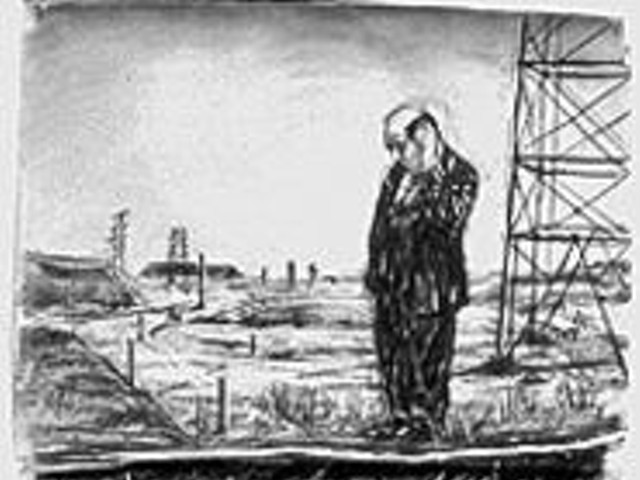With experience, you also learn how to get the most out of these group "theme" shows: When viewing the exhibition, forget the theme. It's just a device anyway, a modicum of structure that prevents a group show from collapsing into a complete artistic free-for-all. This is not meant to detract from the efforts of Adrian Luchini, the artist and Washington University professor of architecture who juried the show. Luchini appears to have done better than most jurors might have, choosing a sensitive collection of 50 pieces in all media that have something to do with structure. But in the end, what Structurally Speaking really amounts to is a strong collection of recent works by regional artists.
The show opens with Rebecca Bailey's "Self Portrait 12.16.99," a large wooden box with air holes and a video image of the artist's face peeking out, as if from her own coffin. Though slightly morbid, the work nevertheless retains an element of humor. Bailey also deserves kudos for working in the most progressive medium of anyone in the show.
Two-dimensional works abound here, and it's a mixed bag in that department. The best paintings in the show belong to Lon Brauer, whose two oil works on panel suggest the human body in only the most sketchy manner. The brushstrokes are to die for -- gorgeous and lyrical, yet fragile. Nannette Vinson's "Untitled: From the Price of Eggs Series," a photo transparency, contains that same fragility. It depicts a heart-wrenching juxtaposition of pristine white architecture and piles of decomposing rubble.
The actual built structures in this show hold less interest than many of the paintings and photographs. Walter Bauer's untitled wood sculpture is a dead ringer for a Jackie Ferrara -- but is it derivative or a conscious homage? Much nicer is Dan Weeks' untitled work, which weaves panoramic photos of cities (Rangoon, New York, Calcutta) into a wooden lattice. It looks like an exercise in urban anthropology taking a sculptural form.
One of the most delightful pieces in the show is William Leslie's "Guardians of the Garden," a whimsical small-scale diorama peopled with plastic mythical superhero figures in a fantastic garden of miniature roses, fountains, ivy vines and mushrooms. There's a story to the scene, told in straight-faced narrative style on a page posted near the piece. But the story (which has something to do with Taurus the bull and astrological mythology) is beside the point; the best thing about the work is its unabashed goofiness and the memories it will spark for those viewers who grew up learning from museum dioramas.
"Guardians of the Garden" is a reminder of how wonderful dioramas can be in an age when diorama-making is becoming a lost art. We probably have natural-history and science museums to blame for that -- exhibition designers decided sometime in the early 1980s that the diorama was uncool as a mode of representing other cultures. (There are, however, great diorama holdouts, such as the museum at Cahokia Mounds.) Leslie isn't in any danger of offending anyone; his diorama deals in fantasy and mythology. But let's hope his work sparks a renaissance of diorama-making in general. The art world could use a little lightening up.
Structurally Speaking continues at Art St. Louis through March 10.





